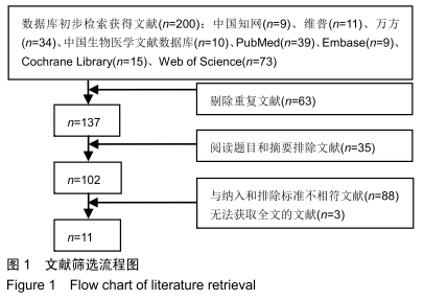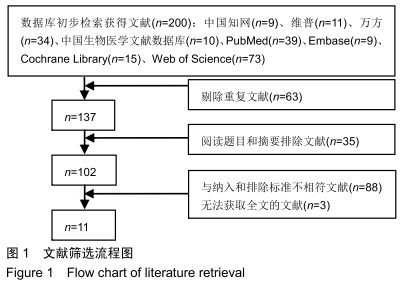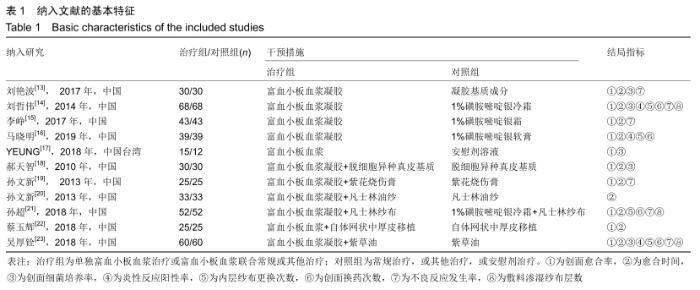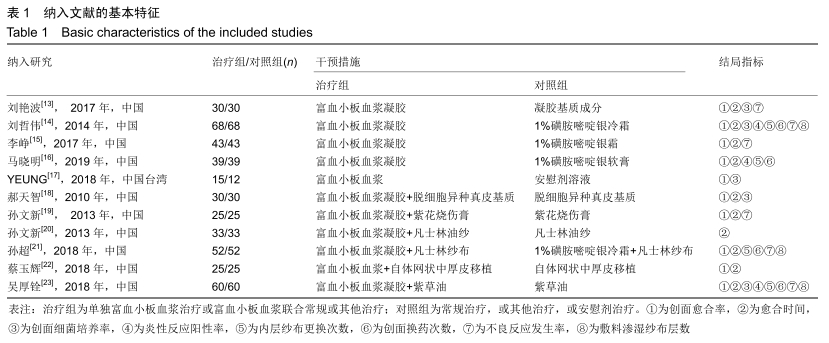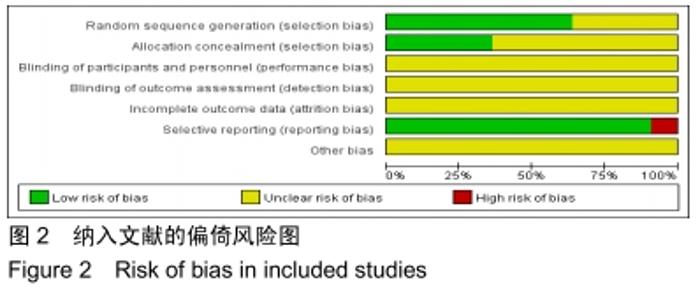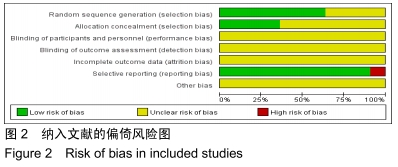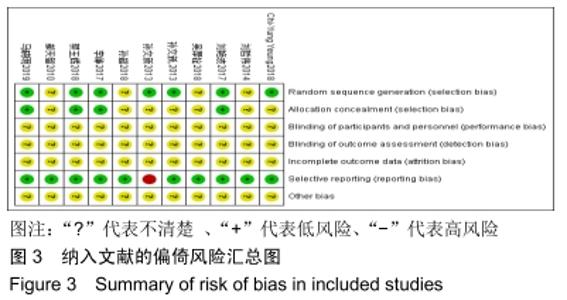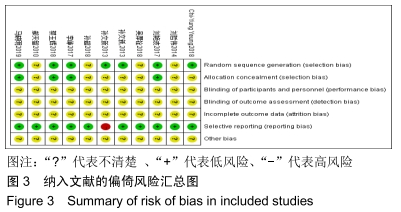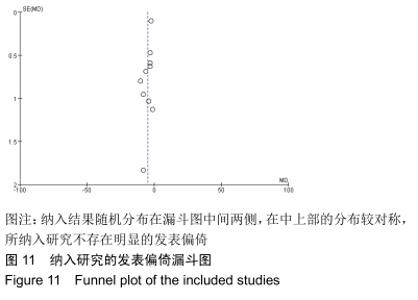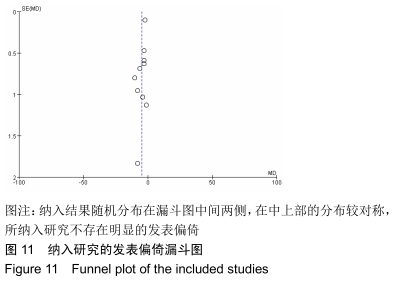Chinese Journal of Tissue Engineering Research ›› 2020, Vol. 24 ›› Issue (14): 2291-2296.doi: 10.3969/j.issn.2095-4344.2240
Meta-analysis of platelet-rich plasma in repairing burn wounds
Zhong Shuxian, Yang Yalan, Shi Yuqing, Li Chun
- School of Nursing, Guangzhou University of Chinese Medicine, Guangzhou 510006, Guangdong Province, China
-
Received:2019-07-23Revised:2019-07-26Accepted:2019-08-23Online:2020-05-18Published:2020-03-18 -
Contact:Li Chun, Master, Associate professor, School of Nursing, Guangzhou University of Chinese Medicine, Guangzhou 510006, Guangdong Province, China -
About author:Zhong Shuxian, Master candidate, School of Nursing, Guangzhou University of Chinese Medicine, Guangzhou 510006, Guangdong Province, China
CLC Number:
Cite this article
Zhong Shuxian, Yang Yalan, Shi Yuqing, Li Chun . Meta-analysis of platelet-rich plasma in repairing burn wounds[J]. Chinese Journal of Tissue Engineering Research, 2020, 24(14): 2291-2296.
share this article
| [1] STANOJCIC M, VINAIK R, JESCHKE MG. Status and challenges of predicting and diagnosing sepsis in burn patients.Surg Infect (Larchmt). 2018;19(2):168-175. [2] PECK MD. Epidemiology of burns throughout the world.Part I: Distribution and risk factors.Burns.2011;37(7):1087-1100. [3] AMERICAN BURN ASSOCIATION. Burn incidence and treatment in the United States:2016.http://ameriburn.org/who-we-are/media/ burn-incidence-fact-sheet,2016/2019-07-20. [4] HUNTER TA, MEDVED MI, HIEBERT-MURPHY D, et al. “Put on your face toface the world”:women’s narratives of burn injury.Burns. 2013; 39(8):1588-1598. [5] HOBBS K.Which factors influence the development of post-traumatic stress disorder in patients with burn injuries?A systematic reviewof the literature.Burns.2015;41(3):421-430. [6] CEN Y, CHAI J, CHEN H, et al. Guidelines for burn rehabilitation in China.Burns Trauma.2015;3:20. [7] ROH YS, CHUNG HS, KWON B, et al. Association between depression, patient scar assessment and burn-specific health in hospitalized burn patients.Burns.2012;38(4):506-512. [8] CHING YH, SUTTON TL, PIERPONT YN, et al. The use of growth factors and other humoral agents to accelerate and enhance burn wound healing.Eplasty.2011;11:e41. [9] 潘红娟,汪丽,刘铁梅.富血小板血浆成分及其作用的研究新进展[J].中国输血杂志,2016,29(12):1408-1412. [10] 周迎慧,吴可佳,吴文育.富血小板血浆治疗雄激素性秃发的临床进展[J].中国美容医学,2017,26(8):27-30. [11] 汤其元,马亚萍,张斌,等.骨组织再生工程中富血小板血浆的应用与研究进展[J].中国组织工程研究,2019,23(4):597-605. [12] HIGGINS JPT GS.Cochrane Handbook for Systematic Reviews of Interventions Version 5.1.0//Cochrane handbook for systematic reviews of interventions/.Wiley-Blackwell,2008:102-108. [13] 刘艳波.自体富血小板血浆凝胶在治疗烧伤残余创面的临床研究[D].银川:宁夏医科大学,2017. [14] 刘哲伟,苏开新,陈军,等.富含血小板血浆外敷在深Ⅱ度烧伤创面修复中的临床应用[J].天津医药,2014,42(12):1213-1215. [15] 李峥.富血小板血浆凝胶在深度烧伤后期创面修复中的作用分析[J].临床医药文献电子杂志,2017,4(8):16096-16097. [16] 马晓明,段鹏.深Ⅱ度烧伤创面修复中富含血小板血浆外敷的作用研究[J].实用医技杂志,2019,26(5):600-602. [17] YEUNG CY, HSIEH PS, WEI LG, et al. Efficacy of Lyophilised Platelet-Rich Plasma Powder on Healing Rate in Patients With Deep Second Degree Burn Injury: A Prospective Double-Blind Randomized Clinical Trial.Ann Plast Surg.2018;80(2S Suppl 1):S66-S69. [18] 郝天智,朱敬民,扈文博,等.自体富血小板血浆凝胶联合脱细胞异种真皮基质治疗深Ⅱ度烧烫伤[J].中国修复重建外科杂志,2010,24(6):647-649. [19] 孙文新,林小青,范施娜.自体富血小板血浆(AGP)对烧伤后残余创面的治疗中的临床观察[J].世界最新医学信息文摘,2013,8(4):152-153. [20] 孙文新,林小青,范施娜.自体富血小板血浆(AGP)对供皮区创面治疗中的临床观察[J].河南中医,2013,28(B10):94. [21] 孙超,李罗珠,陈传俊,等.深Ⅱ度烧伤创面修复中富含血小板血浆外敷的应用研究[J].临床医药文献电子杂志,2018,5(85):64,68. [22] 蔡玉辉,王磊,朱兴华,等.富血小板血浆结合自体网状皮移植治疗Ⅲ度烧伤创面的临床研究[J].南京医科大学学报(自然科学版),2018,38(10): 1446-1450. [23] 吴厚铨,吴杉英.PRP联合紫草油在深Ⅱ度烧伤创面治疗中的临床疗效观察[J].基层医学论坛,2018,22(16):2238-2239. [24] RUIZ A, CUESTAS D, GARCıA P, et al.Early intervention in scar management and cutaneous burns with autologous platelet-rich plasma. J Cosmet Dermatol.2018;17(6):1194-1199. [25] NURDEN AT.Platelets, inflammation and tissue regeneration.Thromb Haemost. 2011;105 Suppl 1:S13-33. [26] MILLER JD, RANKIN TM, HUA NT, et al.Reduction of pain via platelet-rich plasma in split-thickness skin graft donor sites: a series of matched pairs.Diabet Foot Ankle.2015;6:24972. [27] MOOJEN DJ, EVERTS PA, SCHURE RM, et al. Antimicrobial activity of platelet-leukocyte gel against Staphylococcus aureus.J Orthop Res. 2008;26:404-410. [28] 吴宏志,李晓,杨蒙,等.自体富血小板血浆凝胶对中老年电烧伤患者创面愈合的影响[J].中国老年学杂志,2015,35(5):1182-1184. [29] 赵景峰,李涛,李善友,等.自体富血小板血浆联合解毒通肠方对重度烧伤患者肠道功能及创面康复进程的影响[J].四川中医,2017,35(11):142-144. [30] 耿志杰,陈军,刘群峰,等.伤口护理应用医用湿性敷料研究进展[J].护理学报,2017,24(11):27-30. [31] DRURY JL, MOONEY DJ. Hydrogels for tissue engineering:Scaffold design variables and applications.Biomaterials.2003;24(24): 4337-4351. [32] DELLINGER RP, LEVY MM, CARLET JM, et al. Surviving sepsis campaign: international guidelines for management of severe sepsis and septic shock.Crit Care Med.2008;36(1):296-327. [33] 黄跃生.烧伤外科学[M].北京:科学技术文献出版社,2010:521. [34] 贾媛,赵华兴,李行,等.烧伤患者创面感染的研究进展[J].临床与病理杂志, 2019,39(3):634-639. [35] ZHANG W, GUO Y, KUSS M, et al. Platelet-Rich Plasma for the Treatment of Tissue Infection: Preparation and Clinical Evaluation. Tissue Eng Part B Rev.2019;25(3):225-236. |
| [1] | Chen Junming, Yue Chen, He Peilin, Zhang Juntao, Sun Moyuan, Liu Youwen. Hip arthroplasty versus proximal femoral nail antirotation for intertrochanteric fractures in older adults: a meta-analysis [J]. Chinese Journal of Tissue Engineering Research, 2021, 25(9): 1452-1457. |
| [2] | Chen Jinping, Li Kui, Chen Qian, Guo Haoran, Zhang Yingbo, Wei Peng. Meta-analysis of the efficacy and safety of tranexamic acid in open spinal surgery [J]. Chinese Journal of Tissue Engineering Research, 2021, 25(9): 1458-1464. |
| [3] | Hu Kai, Qiao Xiaohong, Zhang Yonghong, Wang Dong, Qin Sihe. Treatment of displaced intra-articular calcaneal fractures with cannulated screws and plates: a meta-analysis of 15 randomized controlled trials [J]. Chinese Journal of Tissue Engineering Research, 2021, 25(9): 1465-1470. |
| [4] | Huang Dengcheng, Wang Zhike, Cao Xuewei. Comparison of the short-term efficacy of extracorporeal shock wave therapy for middle-aged and elderly knee osteoarthritis: a meta-analysis [J]. Chinese Journal of Tissue Engineering Research, 2021, 25(9): 1471-1476. |
| [5] | Wang Yongsheng, Wu Yang, Li Yanchun. Effect of acute high-intensity exercise on appetite hormones in adults: a meta-analysis [J]. Chinese Journal of Tissue Engineering Research, 2021, 25(8): 1305-1312. |
| [6] | Jiang Hongying, Zhu Liang, Yu Xi, Huang Jing, Xiang Xiaona, Lan Zhengyan, He Hongchen. Effect of platelet-rich plasma on pressure ulcers after spinal cord injury [J]. Chinese Journal of Tissue Engineering Research, 2021, 25(8): 1149-1153. |
| [7] | Kong Desheng, He Jingjing, Feng Baofeng, Guo Ruiyun, Asiamah Ernest Amponsah, Lü Fei, Zhang Shuhan, Zhang Xiaolin, Ma Jun, Cui Huixian. Efficacy of mesenchymal stem cells in the spinal cord injury of large animal models: a meta-analysis [J]. Chinese Journal of Tissue Engineering Research, 2021, 25(7): 1142-1148. |
| [8] | Huang Dengcheng, Wang Zhike, Cao Xuewei. Intravenous, topical tranexamic acid alone or their combination in total knee arthroplasty: a meta-analysis of randomized controlled trials [J]. Chinese Journal of Tissue Engineering Research, 2021, 25(6): 948-956. |
| [9] | Li Yan, Wang Pei, Deng Donghuan, Yan Wei, Li Lei, Jiang Hongjiang. Electroacupuncture for pain control after total knee arthroplasty: a meta-analysis [J]. Chinese Journal of Tissue Engineering Research, 2021, 25(6): 957-963. |
| [10] | He Xiangzhong, Chen Haiyun, Liu Jun, Lü Yang, Pan Jianke, Yang Wenbin, He Jingwen, Huang Junhan. Platelet-rich plasma combined with microfracture versus microfracture in the treatment of knee cartilage lesions: a meta-analysis [J]. Chinese Journal of Tissue Engineering Research, 2021, 25(6): 964-969. |
| [11] | Hua Haotian, Zhao Wenyu, Zhang Lei, Bai Wenbo, Wang Xinwei. Meta-analysis of clinical efficacy and safety of antibiotic artificial bone in the treatment of chronic osteomyelitis [J]. Chinese Journal of Tissue Engineering Research, 2021, 25(6): 970-976. |
| [12] | Zhan Fangbiao, Cheng Jun, Zou Xinsen, Long Jie, Xie Lizhong, Deng Qianrong. Intraoperative intravenous application of tranexamic acid reduces perioperative bleeding in multilevel posterior spinal surgery: a meta-analysis [J]. Chinese Journal of Tissue Engineering Research, 2021, 25(6): 977-984. |
| [13] | Zhong Yuanming, Wan Tong, Zhong Xifeng, Wu Zhuotan, He Bingkun, Wu Sixian. Meta-analysis of the efficacy and safety of percutaneous curved vertebroplasty and unilateral pedicle approach percutaneous vertebroplasty in the treatment of osteoporotic vertebral compression fracture [J]. Chinese Journal of Tissue Engineering Research, 2021, 25(3): 456-462. |
| [14] | Li Yang, Zhang Mingyong. Meta-analysis of the effect of double Endobutton and clavicular hook plate on the treatment of acromioclavicular dislocation [J]. Chinese Journal of Tissue Engineering Research, 2021, 25(3): 463-470. |
| [15] | Li Yanle, Yue Xiaohua, Wang Pei, Nie Weizhi, Zhang Junwei, Tan Yonghai, Jiang Hongjiang. Intramedullary nail fixation versus plate fixation in the treatment of displaced midshaft clavicular fractures in adults: a meta-analysis [J]. Chinese Journal of Tissue Engineering Research, 2021, 25(3): 471-476. |
| Viewed | ||||||
|
Full text |
|
|||||
|
Abstract |
|
|||||
